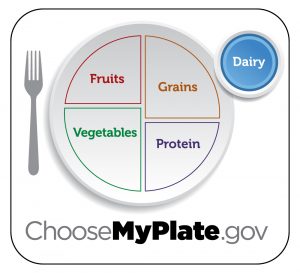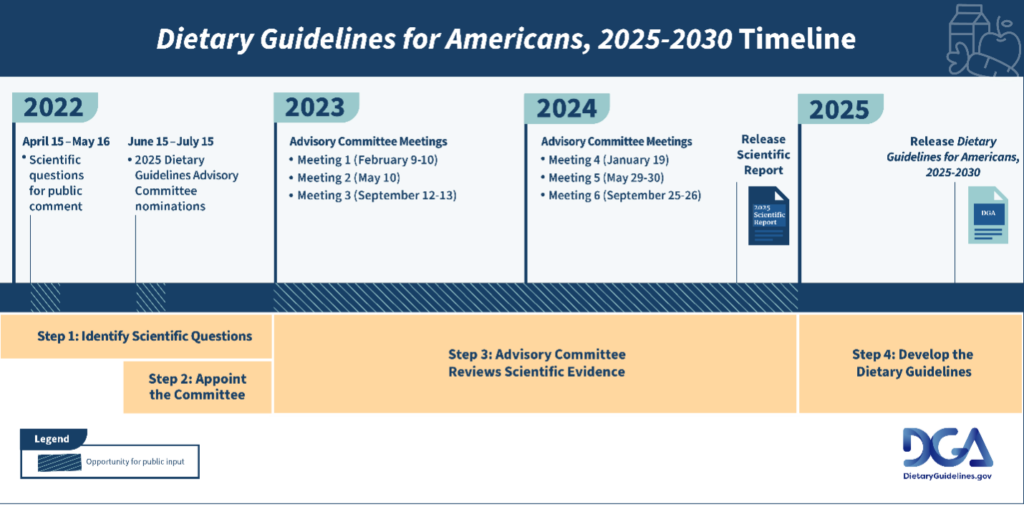
The Dietary Guidelines for Americans (DGA) provide advice on the foods and beverages that will help individuals develop a healthy diet, meet nutrition needs and prevent diet-related diseases. The guidelines also set the standards for federal nutrition programs, such as the school breakfast and lunch programs, and nutrition education messages.
The U.S. Departments of Agriculture and Health and Human Services are required to review and update the guidelines every five years, and the 2020-2025 DGA were released in December 2020. The 2025-2030 DGA are expected in 2025.
Read more about dairy products' nutritional and health benefits on our Dairy Nourishes webpage, and find out more about the new recommendations included in the 2020-2025 Dietary Guidelines for Americans below.
The 2020-2025 Dietary Guidelines for Americans affirm the unrivaled contribution made by dairy foods and remind Americans that a healthy diet includes three daily servings of low-fat and fat-free dairy.
Throughout the development of the new Dietary Guidelines, IDFA shared scientific evidence with the advisory committee to support maintaining the number of servings and expand choices to include higher fat levels. IDFA stressed the importance of keeping dairy as a separate and essential food group and asked the advisory committee, USDA, and HHS to consider nutrient density when assessing dairy products with added sugars.

The process to develop the 2025-2030 DGA is underway. Currently, the DGAC, a panel of 20 nutrition and health experts are reviewing the body of science related to numerous questions related to nutrition and health outcomes, while considering the input of the public. The 2025-2030 DGAC is expected to publish their report in late 2024.
Following this report and additional public input, USDA and HHS will release the final 2025-2030 DGA in 2025.
“Dairy products play an important role in the diet of children… In fact, milk is the leading food source of three of the four nutrients of public health concern (calcium, vitamin D and potassium) in the diet of American children 2-18 years.”
American Academy of Pediatrics
IDFA submitted multiple comments regarding the scientific questions that would be considered by the DGAC and the expertise needed on the DGAC. In September 2023, IDFA's Roberta Wagner provided oral testimony to the advisory committee on the scientific research that supports the inclusion of dairy in healthy diets.
In May 2024, IDFA submitted substantive written comments regarding the science supporting dairy in healthy diets, particularly the science around the health effects of milkfat, the links between dairy consumption and reduced risk of obesity or Type 2 diabetes. Our comments also addressed issues of health equity and the importance of dairy consumption for all groups of Americans.
The Dietary Guidelines Advisory Committee is expected to release its final scientific report to USDA and HHS in late 2024. Following the publication of this report, USDA and HHS will review the report’s recommendations, as well as input from the public and will publish the final DGA, likely in late 2025. These DGA will serve as the basis for the nutritional requirements in the federal nutrition programs, as well as any nutrition messages from the federal government.
Currently, federal nutrition messages and programs are based on the 2020-2025 DGA.
In December 2020, the U.S. Departments of Agriculture (USDA) and Health and Human Services (HHS) released the 2020-2025 Dietary Guidelines for Americans after reviewing the final scientific report of the 2020 DGAC and comments from the public. The agencies once again released guidelines that affirm the unparalleled health and nutrition benefits that dairy products provide to people of all ages:
A diet including low-fat and fat-free dairy is part of the ideal, healthy dietary pattern along with whole grains, legumes, fruits and vegetables.
The guidelines encourage most Americans to consume three servings of dairy per day. Dairy contains key nutrients that Americans should consume more of—also called “food components of public health concern”—including vitamin D, calcium, and potassium.
Dairy remains a separate, distinct food group in recognition of its unrivaled health and nutrition benefits to people of all ages.
Small amounts of some foods including dairy foods are recommended for children beginning at 6-12 months of age and continuing thereafter as part of new recommendations for toddlers. In the second year of life, when calcium requirements increase, dairy products including milk, yogurt, and cheese provide a good source of calcium. The recommendations call for inclusion of higher fat versions of dairy, including whole milk, for toddlers ages 12 through 23 months, which can also help meet calcium, vitamin D and protein needs.
The guidelines contain messages and data useful to combatting misinformation related to dairy. The guidelines state: “Consistent evidence demonstrates that a healthy dietary pattern [including low-fat and fat-free dairy] is associated with beneficial outcomes for all-cause mortality, cardiovascular disease, overweight and obesity, type 2 diabetes, bone health, and certain types of cancer (breast and colorectal).” Additionally, a healthy eating pattern for children from birth through 24 months—which includes the introduction of some dairy after 6 months—helps to “lower risk of asthma” for children.
The Dietary Guidelines rely on the best science to advise Americans on building a wholesome, nutritious diet containing a range of foods and beverages. They are developed after years of review of the latest science on health and nutrition by the Dietary Guidelines Advisory Committee (DGAC), a panel of twenty leading dieticians physicians and public health experts, and officials at USDA and HHS.

Vice President, Regulatory Affairs and Nutrition